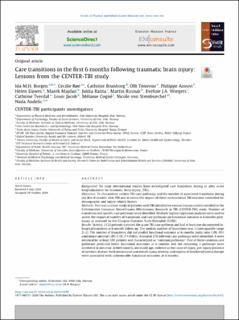| dc.contributor.author | Borgen, Ida Maria Henriksen | |
| dc.contributor.author | Røe, Cecilie | |
| dc.contributor.author | Brunborg, Cathrine | |
| dc.contributor.author | Tenovuo, Olli | |
| dc.contributor.author | Azouvi, Philippe | |
| dc.contributor.author | Dawes, Helen | |
| dc.contributor.author | Majdan, Marek | |
| dc.contributor.author | Ranta, Jukka | |
| dc.contributor.author | Rusnak, Martin | |
| dc.contributor.author | Wiegers, E | |
| dc.contributor.author | Tverdal, Cathrine Buaas | |
| dc.contributor.author | Jacob, Louis | |
| dc.contributor.author | Cogne, Melanie | |
| dc.contributor.author | von Steinbuechel, Nicole | |
| dc.contributor.author | Andelic, Nada | |
| dc.contributor.author | Andreassen, Lasse | |
| dc.contributor.author | Anke, Audny | |
| dc.contributor.author | Frisvold, Shirin | |
| dc.contributor.author | Helseth, Eirik | |
| dc.contributor.author | Røise, Olav | |
| dc.contributor.author | Skandsen, Toril | |
| dc.contributor.author | Vik, Anne | |
| dc.contributor.author | Åkerlund, Cecilia | |
| dc.contributor.author | Amrein, Krisztina | |
| dc.contributor.author | Antoni, Anna | |
| dc.contributor.author | Audibert, Gerard | |
| dc.contributor.author | Azzolini, Maria Luisa | |
| dc.contributor.author | Bartels, Ronald | |
| dc.contributor.author | Barzo, Pal | |
| dc.contributor.author | Beauvais, Romuald | |
| dc.contributor.author | Beer, Ronny | |
| dc.contributor.author | Bellander, Bo-Michael | |
| dc.contributor.author | Belli, Antonio | |
| dc.contributor.author | Benali, Habib | |
| dc.contributor.author | Berardino, Maurizio | |
| dc.contributor.author | Beretta, Luigi | |
| dc.contributor.author | Blaabjerg, Morten | |
| dc.contributor.author | Bragge, Peter | |
| dc.contributor.author | Brazinova, Alexandra | |
| dc.contributor.author | Brinck, Vibeke | |
| dc.contributor.author | Brooker, Joanne | |
| dc.contributor.author | Brorsson, Camilla | |
| dc.contributor.author | Buki, Andras | |
| dc.contributor.author | Bullinger, Monika | |
| dc.contributor.author | Cabeleira, Manuel | |
| dc.contributor.author | Caccioppola, Alessio | |
| dc.contributor.author | Calappi, Emiliana | |
| dc.contributor.author | Calvi, Maria Rosa | |
| dc.contributor.author | Cameron, Peter | |
| dc.contributor.author | Lozano, Guillermo Carbayo | |
| dc.date.accessioned | 2021-11-16T08:53:18Z | |
| dc.date.available | 2021-11-16T08:53:18Z | |
| dc.date.created | 2021-02-08T19:11:51Z | |
| dc.date.issued | 2021 | |
| dc.identifier.citation | Annals of Physical and Rehabilitation Medicine. 2021, 64 (6), . | en_US |
| dc.identifier.issn | 1877-0657 | |
| dc.identifier.uri | https://hdl.handle.net/11250/2829731 | |
| dc.description.abstract | Background: No large international studies have investigated care transitions during or after acute hospitalisations for traumatic brain injury (TBI). Objectives: To characterise various TBI-care pathways and the number of associated transitions during the first 6 months after TBI and to assess the impact of these on functional TBI outcome controlled for demographic and injury-related factors. Methods: This was a cohort study of patients with TBI admitted to various trauma centres enrolled in the Collaborative European NeuroTrauma Effectiveness Research in TBI (CENTER-TBI) study. Number of transitions and specific care pathways were identified. Multiple logistic regression analyses were used to assess the impact of number of transitions and care pathways on functional outcome at 6 months post-injury as assessed by the Glasgow Outcome Scale-Extended (GOSE). Results: In total, 3133 patients survived the acute TBI-care pathway and had at least one documented in-hospital transition at 6-month follow-up. The median number of transitions was 3 (interquartile range 2-3). The number of transitions did not predict functional outcome at 6 months (odds ratio 1.08, 95% confidence interval 1.09-1.18; p = 0.063). A total of 378 different care pathways were identified; 8 were identical for at least 100 patients and characterized as "common pathways". Five of these common care pathways predicted better functional outcomes at 6 months, and the remaining 3 pathways were unrelated to outcome. In both models, increased age, violence as the cause of injury, pre-injury presence of systemic disease, both intracranial and overall injury severity, and regions of Southern/Eastern Europe were associated with unfavourable functional outcomes at 6 months. Conclusions: A high number of different and complex care pathways was found for patients with TBI, particularly those with severe injuries. This high number and variety of care pathway possibilities indicates a need for standardisation and development of "common data elements for TBI care pathways" for future studies. | en_US |
| dc.language.iso | eng | en_US |
| dc.publisher | Elsevier | en_US |
| dc.rights | Navngivelse 4.0 Internasjonal | * |
| dc.rights.uri | http://creativecommons.org/licenses/by/4.0/deed.no | * |
| dc.title | Care transitions in the first 6 months following traumatic brain injury: Lessons from the CENTER-TBI study | en_US |
| dc.type | Peer reviewed | en_US |
| dc.type | Journal article | en_US |
| dc.description.version | publishedVersion | en_US |
| dc.source.pagenumber | 8 | en_US |
| dc.source.volume | 64 | en_US |
| dc.source.journal | Annals of Physical and Rehabilitation Medicine | en_US |
| dc.source.issue | 6 | en_US |
| dc.identifier.doi | 10.1016/j.rehab.2020.10.009 | |
| dc.identifier.cristin | 1887836 | |
| dc.relation.project | Norges forskningsråd: 272789 | en_US |
| dc.relation.project | EU – Horisont Europa (EC/HEU): 602150 | en_US |
| cristin.ispublished | true | |
| cristin.fulltext | original | |
| cristin.qualitycode | 1 | |

